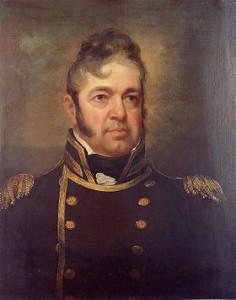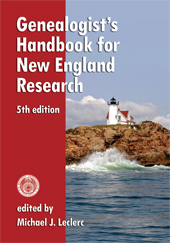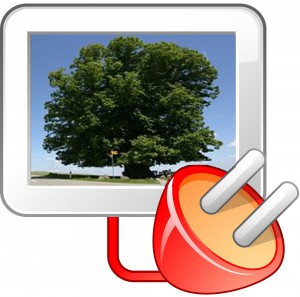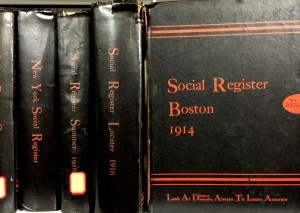One of the best things about working on the reference desk at the New England Historic Genealogical Society is that each new patron brings new challenges. Often new discoveries come with these challenges that I can use down the road to assist another patron. Such an event happened recently. (Click on the images to expand them.) Continue reading Canadian colonization companies: an introduction
Tag Archives: Research tips
Using heraldry for genealogical research

I have had two good personal experiences with heraldry — and no bad ones.
When I was developing the West Indian ancestry of my ancestress, Susanna (Heyliger) Bainbridge, I found that her grandson (my great-grandfather) had drawn up an elaborate coat of arms for her husband, Commodore William Bainbridge, based on the arms of an unrelated Bainbridge family, quartering the arms of an unrelated Taylor family. (The Commodore’s mother was Mary Taylor. For an explanation of quartering arms, see this Wikipedia article.) Included in this heraldic disaster as a single quartering were the supposed arms of the Heyliger family. And, as it turned out, they were valid arms — though not for the Heyliger family. Continue reading Using heraldry for genealogical research
Navigating Connecticut probate and court records
 More than the other New England states, Connecticut has kept its records in a variety of jurisdictions. Probate records can be particularly difficult to navigate. For Connecticut Colony, after 1639, estates were in the jurisdiction of the Particular Court (sometimes called the “Quarterly Court”). The Particular Courts were abolished with the new colony charter in 1662 and replaced by the Court of Assistants. Continue reading Navigating Connecticut probate and court records
More than the other New England states, Connecticut has kept its records in a variety of jurisdictions. Probate records can be particularly difficult to navigate. For Connecticut Colony, after 1639, estates were in the jurisdiction of the Particular Court (sometimes called the “Quarterly Court”). The Particular Courts were abolished with the new colony charter in 1662 and replaced by the Court of Assistants. Continue reading Navigating Connecticut probate and court records
Learning from our mistakes
We often learn from our mistakes. A promise that “I won’t do that again” can be a valuable tool. And, if repeated enough times, it becomes known as experience.
A decade ago I had a luncheon talk entitled “My Ten Worst Mistakes in Genealogy.” When the title appeared, Robert Charles Anderson commented, “and he updates it frequently!” In fact, I do update it, but now I separate the mistakes that did not appear in print or in a lecture from those that did. And I’m glad to say the former far outweigh the latter. Continue reading Learning from our mistakes
A shopping list of technological and genealogical resources
 As I was pulling together information for my upcoming April presentation, “Genealogy on the Go: Mobile Tools to Manage Your Discoveries,” I started thinking about how genealogy and technology go hand-in-hand these days – but that finding out more about the technology part, besides its application to genealogy, can sometimes be confusing for beginning users. Here are some places online I think would be helpful in finding tech information and news, as well as kin and research allies! Continue reading A shopping list of technological and genealogical resources
As I was pulling together information for my upcoming April presentation, “Genealogy on the Go: Mobile Tools to Manage Your Discoveries,” I started thinking about how genealogy and technology go hand-in-hand these days – but that finding out more about the technology part, besides its application to genealogy, can sometimes be confusing for beginning users. Here are some places online I think would be helpful in finding tech information and news, as well as kin and research allies! Continue reading A shopping list of technological and genealogical resources
New England towns, counties, and states
 New England’s governmental organization is different from other areas of the United States, which can confuse genealogical researchers from outside the region. One major difference is in geopolitical subdivisions. Unlike other areas of the country, New England’s primary unit of government is the town. Continue reading New England towns, counties, and states
New England’s governmental organization is different from other areas of the United States, which can confuse genealogical researchers from outside the region. One major difference is in geopolitical subdivisions. Unlike other areas of the country, New England’s primary unit of government is the town. Continue reading New England towns, counties, and states
What we inherit, or, critical analysis
 The seventy-ninth anniversary of my parents’ marriage falls on 30 March 2014. They were married for 71 years before my mother’s death at age 99 years, 6 months, and 9 days in 2006. Mom was my connection to genealogy. Her mother was the last of her branch of the family and inherited and treasured all of the possessions, lore, and memories that came down to her. They’ve all been passed to me now. Continue reading What we inherit, or, critical analysis
The seventy-ninth anniversary of my parents’ marriage falls on 30 March 2014. They were married for 71 years before my mother’s death at age 99 years, 6 months, and 9 days in 2006. Mom was my connection to genealogy. Her mother was the last of her branch of the family and inherited and treasured all of the possessions, lore, and memories that came down to her. They’ve all been passed to me now. Continue reading What we inherit, or, critical analysis
Mining the Social Register, an unexpected resource
 In my role as a technical services librarian, I’ve recently been working on adding issues of the Social Register published between 1890 and 1923 to the NEHGS Digital Library. Started in 1886, this publication is a directory of names and addresses of prominent American families. At its inception, the Social Register was primarily populated by descendants of early Dutch and English settlers of New York, but the scope of the series quickly expanded, and by 1918 there were eighteen annual volumes representing twenty-three U.S. cities. The Social Register Association continued publishing separate volumes for different cities until 1976, when the listings were consolidated into a single publication. Continue reading Mining the Social Register, an unexpected resource
In my role as a technical services librarian, I’ve recently been working on adding issues of the Social Register published between 1890 and 1923 to the NEHGS Digital Library. Started in 1886, this publication is a directory of names and addresses of prominent American families. At its inception, the Social Register was primarily populated by descendants of early Dutch and English settlers of New York, but the scope of the series quickly expanded, and by 1918 there were eighteen annual volumes representing twenty-three U.S. cities. The Social Register Association continued publishing separate volumes for different cities until 1976, when the listings were consolidated into a single publication. Continue reading Mining the Social Register, an unexpected resource
New York newspapers as a substitute for vital records
 In the 22 January 2014 issue of NEHGS’ Weekly Genealogist, a ‘story of interest’ highlighted the sad plight of 17,000 square feet of old newspapers held by the New York State Library in Albany. Faced with the demand to archive an increasing amount of education department paperwork, the article – “State Library’s Tough Calls on What to Save, What to Shred” – illustrated how once treasured collections are now losing the battle for available storage space. Continue reading New York newspapers as a substitute for vital records
In the 22 January 2014 issue of NEHGS’ Weekly Genealogist, a ‘story of interest’ highlighted the sad plight of 17,000 square feet of old newspapers held by the New York State Library in Albany. Faced with the demand to archive an increasing amount of education department paperwork, the article – “State Library’s Tough Calls on What to Save, What to Shred” – illustrated how once treasured collections are now losing the battle for available storage space. Continue reading New York newspapers as a substitute for vital records
Just how reliable is that source?

Many of us have been betrayed, genealogically speaking, by a source that appears to be reliable but is not. Often the source is reliable for the most part. But that fact gives you no comfort when the information in which you are interested turns out to be incorrect. Continue reading Just how reliable is that source?
